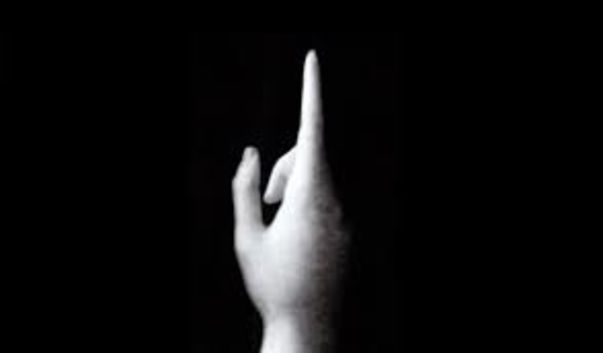To those who will come after us
By Juliana Costa

The first image: a finger pointing up. “Think with your hands”, says Godard’s fragile voice over the image. Not a just hand, but just a hand. The hand of St. John the Baptist, an androgenic prophet, who in the celebrated painting of Leonardo da Vinci points up, foretelling the arrival of those who will come later. Dedicated “to those who will come after us”.
In The Image Book, Jean-Luc Godard evokes the archeology of images from the series Histoire(s) du cinéma, especially in the first half. The archeology of images’ archeology, as he works with intertitles and scenes from the series. “The image will come at the time of the resurrection”, Godard said in Histoire(s) du cinéma (or will it be the time of the resurrection?), and as such re-updates all of the times. Forever and ever the doorman from The Last Laugh accompanies the ladies in the rain, and Johnny Guitar will ask Vienna to lie. Also, forever and now the bomb explodes before our eyes (horror, horror, horror). “Do you really not want to become immortal?”. “What will become of me if I do not die?”. In the Malraux’s imaginary museum, time is the distance between two frames. Or between two sequences. No matter the temporal distance – there is no time in the resurrection – but the cut, the passage, the relationship. Godard's sweet obsession.
The Image Book is also a compliment to fragment. A fragment of memory, history, image. An ode to Bertold Brecht: “Only the fragment can preserve authenticity”. At the same time (always at the same time) the violence. Godard violates the fragments, violates the images, as an appropriation, as a declaration of love and horror. The love and horror driving the filmmaker who declared, to the despair of contemporary philosophers, that image thinks.
In the second part of The Image Book, the violence of the act of representing. The contrast between the act of representing and the lull of the depiction of the North American invasion of the Middle East, Godard’s bitter obsession. Goodbye to language. Anne Marie’s voice proclaims: “The abandoned land, buried with letters of the alphabet, swollen with knowledge, and no one listens”. How to embody the images of horror? Take them out of the ghostly maze of the eternal return, in which the bomb and the kiss repeat infinitely with equal intensity? We are never sad enough for the world to be better.
In the end, the dance. The dance will come at the time of the resurrection and Godard’s dance has the face of a woman.

